Painting Of The Dutch Century
 From Conservapedia
From Conservapedia 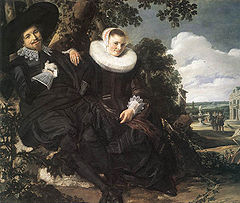
The Dutch Century or the Dutch Golden Age is a period in Dutch history in which the Dutch Republic had a phenomenal rise to prosperity. It was over the course of the 17th century that great advancements in the economy, military, trade, arts and sciences took place.
The Dutch nation became one of the wealthiest and most powerful in the world, employing its naval prowess to dominate international trade and create a vast colonial empire... What followed was an enormous surge in art production in an unprecedented variety of types and levels of quality. [1]
The land of Rembrandt, Jan Vermeer, Frans Hals, and other renowned painters, it produced artistic riches still treasured. With a flourishing literary and intellectual life, it provided a congenial environment for the rise of rationalism. [2]
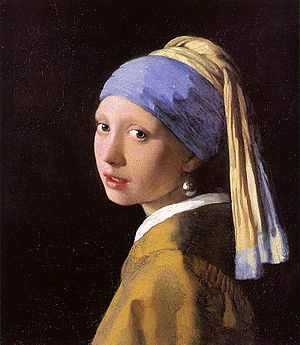
Dutch Golden Age painting[edit]
Dutch painting of the Golden Age comes in the period of Baroque painting. However, it lacks the idealization and love to splendor, typical in much Baroque artists, reflecting a realism inherited from Early Netherlandish painting. In this period, a proliferation of distinct genres of paintings is conducted. With a small amount of religious painting, other genres like scenes of peasant life, landscapes, townscapes and cityscapes, seascapes, and still lifes of various types, specially flower paintings, all were enormously popular.
Seventeenth-century Netherlanders had a passion for depictions of city and countryside, either real or imaginary. Local scenery asserted Holland’s national pride, while vistas of foreign sites recalled the extent of its overseas commerce. Holland’s ocean ports teemed with fishing and trading ships, and the tiny country’s merchant fleet was almost as large as all the rest of maritime Europe’s combined. [3] Maritime painting was enormously popular in Dutch Golden Age. Amsterdam was the largest artistic center.
The Dutch prized seascapes and insisted on accurate renderings of each hull and rigging line. Genre incidents from everyday life animate most Dutch landscapes and seascapes. Ibidem
Famous painters of this age were:
- Hendrik Cornelisz Vroom (Haarlem, ca. 1562/1563 – Haarlem, 1640) was a painter credited with being the founder of Dutch marine art or seascape painting.
- Ambrosius Bosschaert (1573–1621), a flower painter who founded a dynasty. He was one of the early Still life painters of the Dutch Republic.
- Frans Hals (ca. 1582–1666) painter born in the Southern Netherlands (present-day Belgium) was principally a portraitist, but also painted genre.
- Esaias van de Velde (1587–1630) who was a landscape painter.
- Gerard (Gerrit) van Honthorst (1592–1656) was a leading portrait painter. He became one of the few Dutch painters to achieve international fame in his lifetime. The Utrecht painter van Honthorst popularised candle-light scenes. This Dutch painter was a leading member of the Utrecht school influenced by the Italian painter Caravaggio. [4]
- Balthasar van der Ast (Middelburg, 1593 ó 1594 - Delft, 1657) pioneered still lifes of shells, as well as painting flowers.
- Willem Claeszoon Heda (1593/1594 – ca. 1680/1682) was an artist devoted exclusively to the painting of still lifes. He is known for his innovation of the late breakfast genre of Still life. Willem Claeszoon Heda and Willem Kalf led the change to the pronkstilleven in the mid 17th century.
- Pieter Claesz (1597-1660) preferred to paint simpler "ontbijt" ("breakfast pieces"), or explicit vanitas pieces. For him, the principal aim was to render the materials and catch the reflected light as accurately as possible. This was his speciality. [5]
- Salomon van Ruysdael (1602–1670), a landscape, river scenes and fish still life painter. He was one of the pioneers of the landscape genre.
- Rembrandt Harmenszoon van Rijn (Leiden, 1606 – Ámsterdam, 1669) who began as a history painter before finding success as a portraitist. Rembrandt is known as a painter of light and shade, possessing an exceptional ability to render people in their various moods and dramatic guises. [6]
- Philips Wouwerman (1619–1668) added men and horses to turn a landscape into a hunting scene.
- Willem Kalf (1619–1693) who specialized in still lifes. Later in his life, Kalf became an art dealer.
- Abraham van Beijeren (ca. 1620–1690) chosed birds, as well as dead fish for his paitings.
- Willem van Aelst (1627–1683) who excelled in the genre (painters from Leiden, The Hague, and Amsterdam particularly excelled in the genre. The Utrecht Caravaggisti Hendrick ter Brugghen (1588–1629), as well as Judith Leyster, were genre painters of the Dutch Republic). [7]
- Jacob Isaacksz van Ruisdael (ca. 1629–1682), a prolific and innovative landscape painter. He is regarded as the greatest of all Dutch landscape painters; van Ruisdael excelled in the painting of cloudscapes.
- Johannes Vermeer (1632–1675) who worked in domestic interior scenes, producing paintngs like "Girl with a Pearl Earring", (1665), "The Milkmaid" (c. 1658) and "The Girl with the Wine Glass", ca. 1659.
- Adriaen van de Velde (1636 — 1672) painter, draftsman, and etcher, who specialized in landscapes and animals; he also added people or farm animals.
Kalf produced still lifes featuring imported fruits and expensive objects such as Chinese porcelain, Venetian glassware, and silver-gilt cups and trays, usually rendered in glistening light and a velvety atmosphere. In these works and later flower pictures by de Heem, Willem van Aelst, Rachel Ruysch, and the highly influential Jan van Huysum, the emphasis upon aesthetic appeal and decorative function evident in almost all still-life painting is more conspicuous than ever before. [8]
Kalf selected objects of high aesthetic appeal centered around a large bulbous porcelain pot with blue and white glaze. This also appears in other works on Kalf (in the Louvre, Paris, the Museum Prinsenhof, Delft, the Musée de Picardie in Amiens and the Museum of Art, Indianapolis).
Willem Kalf is considered by many experts "the most important still-life painter of the Dutch Golden Age" (Cat. "Painted Light", Aachen 2007, p. 7). It documents his ability to "stunning compositions in which to play the effect of chiaroscuro and inventive reflections of light on metal and glass. [9]
Several types of subject were recognised for Still life:
Still life painting flourished during the Golden Age of the Dutch Republic.
The so-called monochrome "banquet" or "breakfast" still life; it was more common in the mercantile city of Haarlem; Floris van Dyck, Pieter Claesz, Willem Claeszoon Heda, and others arranged familiar foods (ham, cheese, oysters, and so on) and glasses of wine or beer on wooden tabletops. [10] Ontbijtjes, simpler "breakfast pieces". Willem Claeszoon Heda and Pieter Claesz were the creators and masters of the “Small Breakfast” pieces (Ointbijtjes is Dutch for small breakfast), They were mostly almost monochromatic; due to the limited color palette used in most of these pieces, they look quite similar. [11]
Banquet, Banketje or small banquet, were "banquet pieces"; they were very similar to breakfast pieces but, the food items were what were typical in wealthy home.
The vanitas theme where still lifes that had a moralistic message, usually concerning the brevity of life. Vanitas still lifes were a specialty of Leiden artists such as Jan Davidsz de Heem and David Bailly. Pieter Claesz was influenced by this artistic movement. One of Willem Claeszoon Heda's earliest work was a Vanitas.
From the mid-century the pronkstilleven ("ostentatious still-life"), showing expensive and exotic objects, became more popular. This was the favorite theme of Willem Kalf who is regarded as the “father” of this style. Adopted by Peter Van Beyeren, Pieter the Ring, Janz Davidz de Heem, Floris Claesz van Dijck and later painters who choose sumptuous objects and very vivid colors.
Kalf's magnificent still life paintings vary little in their structure, and most of them actually feature the same objects. Usually, a damask cloth or tapestry is draped upon a table on which there is a tableware, with gold and silver vessels; there is almost always a Chinese porcelain bowl, often tilted so that the fruits tumble out of it. [12]
Flower paintings formed a sub-group with its own specialists, occasionally the speciality of the few women artists, such as Maria van Oosterwyck and Rachel Ruysch.
The magnificent still life paintings of the Dutch Golden Age depict tables richly laid with an array of products that attest to the vast scope of the Dutch trade network. [13]
The success of 17th century Dutch painting influenced the work of subsequent generations. They settled the tradition of Still life painting.
Rembrandt, Self-Portrait in a Flat Cap, 1642
Jan Vermeer, View of Delft, 1660-1661.
See also[edit]
- Gallery of Dutch Still life Masterpieces
- Gallery of Flemish and Dutch painting
- Flemish School of Painting
- Masterpiece
- Gallery Francisco de Goya
External links[edit]
- Rembrandt van Rijn. Britannica Online Library Edition.
- DUTCH AND FLEMISH PAINTING OF THE 16TH-17TH CENTURIES.
- Significant Collections of 17th-century Dutch Painting in the World.
MAKING ART WITH ART
Categories: [Painting] [Dutch History]
↧ Download as ZWI file | Last modified: 02/08/2023 18:18:16 | 15 views
☰ Source: https://www.conservapedia.com/Painting_of_the_Dutch_Century | License: CC BY-SA 3.0
 ZWI signed:
ZWI signed:

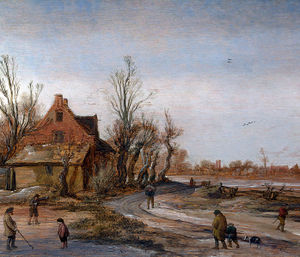


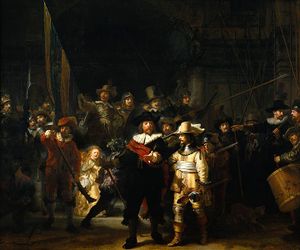





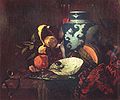



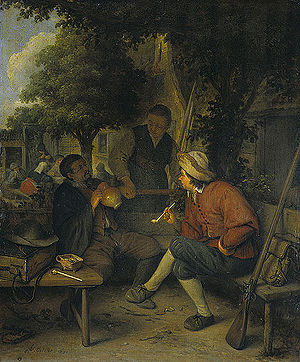



 KSF
KSF